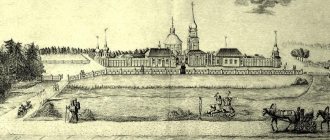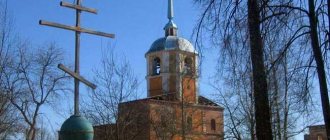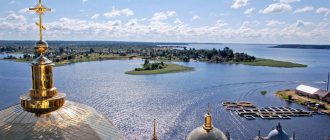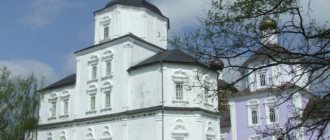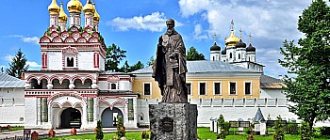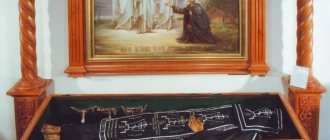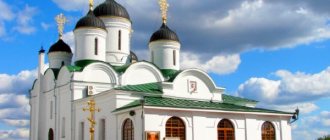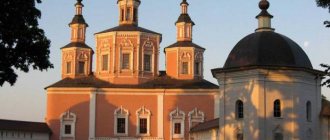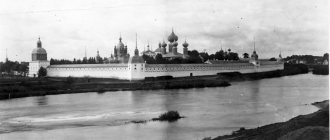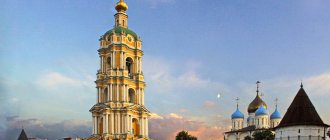| Pyatigorsk St. Michael the Archangel Church. Photo beginning XXI century |
Pyatigorsk and Circassian Diocese
of the Russian Orthodox Church
- Diocesan administration: Russia, 357500, Stavropol Territory, Pyatigorsk, st. Pastukhova, 1
- Tel.; fax: 33-04-88
- Official site:
- Canonical territory: Pyatigorsk, Essentuki, Zheleznovodsk, Kislovodsk and Lermontov, as well as Mineralovodsk, Predgorny and Kirov districts of the Stavropol Territory; Kabardino-Balkarian and Karachay-Cherkess Republics.
- Cathedrals: Spassky in Pyatigorsk (under construction), Michael-Arkhangelsk in Pyatigorsk, Marie-Magdalinsky in Nalchik, Nikolsky in Cherkessk
- On the map: Yandex.Map, Google map
The department, named after the city of Pyatigorsk, was established as a vicariate of the Vladikavkaz diocese on September 22, 1910.
In 1916, the region of the Caucasian Mineral Waters became part of the transformed Caucasian and Stavropol diocese, and since 1922 or 1923 the Pyatigorsk diocese has existed as the Stavropol Vicariate. In 1922-1931 there was a Pyatigorsk renovationist diocese.
On June 27, 1927, it was separated from the Stavropol diocese as an independent diocese. The hieromartyr Dimitri (Dobroserdov) appointed to it stayed in Kislovodsk and administered the diocese secretly. The diocese ceased to exist at the end of the 1930s. With the streamlining of the diocesan structure in 1943, the territory of the destroyed diocese again became part of the Stavropol diocese.
It was restored on March 22, 2011, having been separated from the Stavropol diocese within the Mineralovodsk, Predgorny and Kirov regions in the south of the Stavropol Territory, as well as the republics of Kabardino-Balkaria and Karachay-Cherkessia [1].
On June 7, 2012, the deaneries of the Pyatigorsk diocese, located on the territory of the Stavropol Territory, were included in the Stavropol Metropolis [2].
Historical names
- Pyatigorskaya (vicariate, September 22, 1910 - ?)
- Pyatigorskaya and Prikumskaya (vicariate, 1922/1923 - 1925)
- Pyatigorskaya and Budennovskaya (June 27, 1927 - late 1930s)
- Pyatigorskaya and Cherkesskaya (since March 22, 2011)
Statistics
- June 2011 - 136 parishes, 21 chapels, 139 churches (136 parishes, 3 monasteries); 153 full-time clergy (138 priests, 15 deacons); 24 monastics (cassophore and mantle; including 2 archimandrites, 4 hieromonks, 2 hierodeacons); 139 parochial schools
- January 2012 - 158 parishes, 162 churches (158 parish, 4 monastic); 150 full-time clergy (133 priests, 17 deacons); 24 monastics (cassophore and mantle; including 1 archimandrite, 4 hieromonks, 2 hierodeacons); 158 parochial schools
- May 2014 - 3 monasteries, 158 parishes, 162 churches (158 parish, 4 monastic), 151 full-time clergy (136 priests, 15 deacons), 24 monastics (ryassophore and mantle), including 12 clergy (3 archimandrites, 7 hieromonks, 2 hierodeacons), 108 parochial schools
Bishops
Vicariate of the Vladikavkaz diocese
- Arseny (Smolenets) (October 22, 1910 - April 17, 1912)
- David (Kachakhidze) (April 17, 1912 - February 14, 1914)
Vicariate of the Stavropol diocese
- Job (Rogozhin) (November 26, 1923 - November 27, 1925)
Independent diocese
- Sschmch. Thaddeus (Uspensky) (June 27 - October 27, 1927) [3]
- Sschmch. Dimitry (Dobroserdov) (1927 - December 31, 1928)
- Nikifor (Efimov) (February - December 15, 1930)
- Pavel (Vilkovsky) (December 15, 1930 - May 1932) [4]
- Sschmch. Dimitry (Dobroserdov), 2nd time (June 27 - October 2, 1932)
- Sschmch. Joasaph (Zhevakhov) (September 19 - October 28, 1932)
- Peter (Savelyev) (October 28, 1932 - March 8, 1933)
- Methodius (Abramkin) (March 8, 1933 - October 1937) [5]
- Feofilakt (Kuryanov) (from March 22, 2011)
In RUSSIA:
DIVEEVO: - March 6; 26 March; April 16; May 7; May 28; June 18; July 9; July 30; August 13; September 3; September 24; October 8. Date-day of departure by train from Moscow. Cost 4500 + train, includes: 2 meals a day, excursion to Diveevo, excursion and transport services along the entire route, overnight stay in a cottage with 2-3 bed rooms.
Geography of deaneries
- Essentuki (Essentuki municipality and part of the Predgorny district -) [6]:
- Essentuki, village. Gorny, st. Essentukskaya, s. Sanamer, s. Harvest
- Kislovodsk, st. Bekeshevskaya, st. Borgustanskaya, Zelenogorsky village, village. Nezhinsky, s. Podkumok, st. Suvorovskaya, s. Yasnaya Polyana
- Lermontov, s. Vinsady, s. Novoblagodarnoye, Pyatigorsky village, p. Sadovoye, s. Etoka, s. Yutsa
- Mineralnye Vody, village Civil, s. Greek, Zheleznovodsk, village. Snake, p. Levokumka, s. Leninsky, p. Maryiny Kolodtsy, village. Nagutskoye, s. Orbelyanovka, s. Pobegailovka, s. Ulyanovka
- Nalchik, village Alexandrovskaya, Baksan, village. Blagoveshchenka, st. Ekaterinogradskaya, Zvezdny village, st. Kotlyarevskaya, s. Kremenchug-Konstantinovskoye, Maysky, Nartkala, village. Novoivanovskoe, village Novopoltavskoe, village Priblizhnaya, Prokhladny, village. Sovkhoznoye, st. Soldatskaya, Tyrnyauz
- Novopavlovsk, s. Zolskaya, s. Sovetskaya, p. Novosrednenskoye, village Staropavlovskaya, s. Maryinskaya, village Komsomolets, s. Orlovka
- Pyatigorsk, st. Konstantinovskaya, Nizhnepodkumsky settlement, hut. Khoroshevsky,
- Cherkessk, village Caucasian, p. Krasnogorskaya, Sadovy settlement, village. Sparta, Udarny settlement, Ust-Dzheguta, Erken-Shahar settlement
- Art. Zelenchukskaya, st. Ispravnaya, Karachaevsk, st. Kardonikskaya, village Kosta Khetagurova, village Kurdzhinovo, village. Leso-Kefar, village. Marukha, s. Nizhny Arkhyz, Ordzhonikidzevsky village, st. Pregradnaya, st. Watchdog, Teberda
The Caucasus defends its god from the Russian Orthodox Church
The next pilgrimage to the mountain Shoanin temple was organized by the Pyatigorsk and Circassian diocese on May 6. Photo by Evgeny Kalinin from the site www.pravoslavie.ru
On June 14, the Congress of the Karachay People, in a publication on its website, complained that the authorities of the Karachay-Cherkess Republic (KCR) were planning to put pressure on this public organization. According to activists, the regional administration was angry with them because of a recent appeal to Patriarch Kirill with a request to remove the Archbishop of Pyatigorsk and Circassia Theophylact (Kuryanov). According to social activists, the diocese of the Russian Orthodox Church is encroaching on 10th-century Alan churches located on the territory of the republic. These are the most ancient Christian architectural monuments in Russia.
Local peoples consider themselves, along with the Ossetians, the heirs of medieval Alania, during which several temples were built in the Zelenchuk region and on Mount Shoan. In their opinion, the religious affiliation of the monuments cannot be defined as Orthodox, because the churches of the historical Alan diocese appeared in the North Caucasus even before the split of Christianity into Western and Eastern. Circassian social activists have been protesting against the actions of the diocese for several years, filing complaints with law enforcement agencies, and this time they decided to write to the head of the Russian Orthodox Church. Simultaneously with the letter to the patriarch, an appeal to Prosecutor General Igor Krasnov was published on the website.
This time, activists were outraged by the liturgy that Archbishop Theophylact celebrated on May 6, the day of remembrance of St. George the Victorious, in a church on Mount Shoan, near the village of Kosta Khetagurova. The Circassian “elders” were outraged that the event was attended by Cossacks, members of the Ossetian community and military personnel, and the worship service and pilgrimage of believers were not agreed upon with representatives of local peoples. The Circassians are also dissatisfied with the fact that the hero of the Caucasian Nart epic Uastirdzhi is identified in the Russian Orthodox Church with the Christian Saint George. The Orthodox clergy dedicated the Shoanin temple to the Victorious. According to local residents, the mythical hero Uastirdzhi, who performs his deeds on the three-legged horse Ausurg, is of exclusively pagan origin.
If we turn to the “Mythological Dictionary”, prepared in 1991 by the editorial board with the participation of such generally recognized specialists in philology as Eleazar Meletinsky, Sergei Averintsev and Aza Taho-Godi, then there is still a mention of the identification of Uastirdzhi with St. George. On the other hand, in the dictionary this hero of the Nart epic is called “a celestial being, the father of Satan,” the Ossetian god of war.
According to the authors of the appeal to Patriarch Kirill, the Pyatigorsk Archbishop “ideologically frames these services in interethnic and interfaith oppositions.” “All this is the basis for insinuations and provocations that contribute to inciting ethnic hatred in one of the most multinational and multi-religious regions of the country, not only in the Karachay-Cherkess Republic, but throughout the entire territory of the North Caucasus Federal District, since not only the Karachay-Balkar people, but also dozens of other peoples of the Caucasus,” write social activists.
“The community, consisting of local Ossetians (3,142 people as of 2010), has been living mainly in the Karachay district for a long period, but during this time no attempts have been made to build their own Orthodox prayer house or church in which they could hold services, not exposing the ancient temples of the republic, which date back to the pre-Orthodox era, to wear and tear and destruction, and especially not changing their authentic ancient appearance with clumsy buildings of pagan symbols, the letter also says. – There are a sufficient number of churches in the KCR (more than 37), and in the capital of the republic, in the very center of the city, with the participation of representatives of all the peoples of the KCR, a huge cathedral of St. Nicholas the Wonderworker was built, however, unfortunately, it should be noted that most of the time it is empty in the absence of parishioners who would visit it systematically.” “We ask you to rid the public of the Karachay-Cherkess Republic from this provocateur - to recall him from performing the high duties of an archbishop on the territory of the Karachay-Cherkess Republic,” write the authors of the appeal about Archbishop Theophylact.
If Patriarch Kirill does not fulfill the demands of the authors of the letter, they intend to seek the truth from President Vladimir Putin and Patriarch Bartholomew of Constantinople. The appeal was signed by the leaders of the Union of Repressed Peoples of Russia, the Congress of the Karachay People, the Council of Elders of the Karachai ROO "Karachai Alan Khalk" and other NGOs.
In response to a request to comment on the situation, the press secretary of the Pyatigorsk and Circassian diocese, Archpriest Mikhail Samokhin, sent the following letter to the editorial office of NGR: “The clergy and believers are and perform divine services in the Shoanino temple as pilgrims. At the same time, mass pilgrimage and worship on the basis of current legislation are pre-coordinated with the government agency that operationally manages this temple on behalf of the owner. Divine services are performed only after receiving approval. We thank the leadership of the republic and representatives of the museum community for their respectful attention to pilgrims and the requests of believers.”
Samokhin also said that in the village of Kosta Khetagurova there is a permanent Orthodox community. Thus, he rejected opponents’ claims that there are no permanent believers of the Russian Orthodox Church in the vicinity of Mount Shoan.
A representative of the diocese clarified with which government institutions services in historical monuments are coordinated: “Until 2018, this was the Russian State Budgetary Institution “State Karachay-Cherkess Historical, Cultural and Natural Museum-Reserve named after M.O. Baichorova”, from 2021 – KChRGBU “Alan Christian Center in the North Caucasus”.
The “Alan Christian Center” that Samokhin speaks of is a separate irritant for the Congress of the Karachay People. The center was created in March 2021 at the direction of the head of the Karachay-Cherkess Republic Rashid Temrezov specifically for the management of five medieval Alanian temples, including Shoaninsky. The new organization was separated from the museum-reserve named after M.O. Baichorova, and it was precisely these actions of the republic’s leadership in the summer of that year that aroused the indignation of Karachay social activists. The Congress wrote to the Minister of Culture Vladimir Medinsky. Activists drew the attention of the then minister to the fact that ancient monuments were moving from federal to republican subordination: “The fact that the leadership of Karachay-Cherkessia destroyed the structure of the museum of the reserve ... by confiscating the above objects to the treasury of the Karachay-Cherkess Republic is alarming.”
Despite the fact that such disputes have been going on for several years now, the Pyatigorsk and Circassian diocese continues to develop ancient monuments. The Moscow church leadership does not seem to see a problem, calling the protesters a “marginal group.” For example, the deputy manager of the Moscow Patriarchate, Bishop Savva (Tutunov), believes that Archbishop Theophylact “in his involvement in the life of the diocese and the region, in his - in secular terms - good contact with the clergy in particular and people in general, represents a wonderful image of a Russian Orthodox bishop in the Caucasus region." “Of course, the presence of such a bishop is not at all beneficial to those who, both inside Russia and abroad, are interested in leveling Russia’s strong presence in the Caucasus,” Tutunov wrote in his Telegram channel.
“Until the mid-2000s, conversion to Orthodoxy meant de facto Russification,” Roman Lunkin, deputy director of the Institute of Europe of the Russian Academy of Sciences, explained to NGR. – A change in attitude towards national languages and traditions in church life has begun to occur over the last 10–15 years, including under the influence of the success of Protestants among the indigenous peoples of Russia. If in the 1990s and early 2000s Orthodox missionaries were in direct conflict with local religions, such as paganism in Yakutia or shamanists in Buryatia, now the problems are different. And the situation in North Ossetia and the Karachay-Cherkess Republic clearly shows this.” “Officially not recognizing the mission among other nations, the Russian Orthodox Church began to carry it out with the translation of services, the ordination of local clergy, the Orthodoxization of holy places and epic heroes, as in Ossetia. Bishop Theophylact established contacts between the diocese and the Cossack villages and believes that the church should play a large role in society. However, not everyone is happy about this; the elders were outraged by the services in the temples of Arkhyz, and the Ossetian pagans were outraged by the construction of a chapel in the sacred grove,” said Lunkin.
Political scientist Alexey Malashenko considers what is happening in Karachay-Cherkessia to be manifestations of “indelicacy and underestimation of cultural diversity, and at the same time a sense of superiority, primacy in the religious life of the country” on the part of the Russian Orthodox Church. “Ethnic and cultural harmony is being violated out of the blue, and in a region where the situation in this regard is far from the simplest. This is a mistake that the patriarchy will never admit - again, out of a feeling of unconditional primacy,” the expert told NG.
The indelicacy of the Moscow Patriarchate does not yet seem fatal. However, the experience of the end of the 20th century shows the political consequences of hurt national feelings. Let us remember that the upheavals of the late 1980s often began with protests by a handful of activists who suddenly decided to stand up for a sacred grove or ancient mounds. Prolonged ignorance of national movements only led to the growth and deepening of the conflict. And then you can’t solve problems with a rush – even if you managed to saddle the three-legged horse Ausurg.
Educational establishments
Higher
- Department of Theology at the Faculty of Public Service and Management of Pyatigorsk State Linguistic University
Average
- NGOU Orthodox St. Nicholas Classical Gymnasium
- Municipal educational institution secondary school No. 21
- Municipal educational institution secondary school No. 27
Preschool
- NGOU kindergarten at the Holy Cross Church in Kislovodsk
